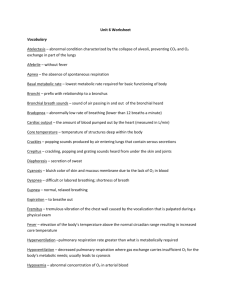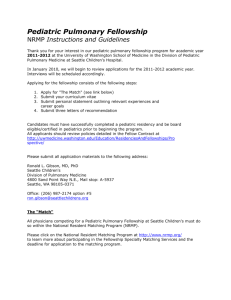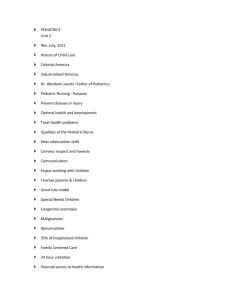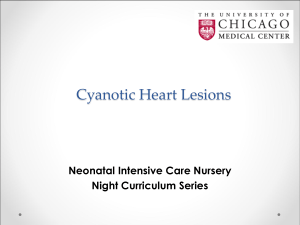Pediatric Cardiovascular Assessment
advertisement
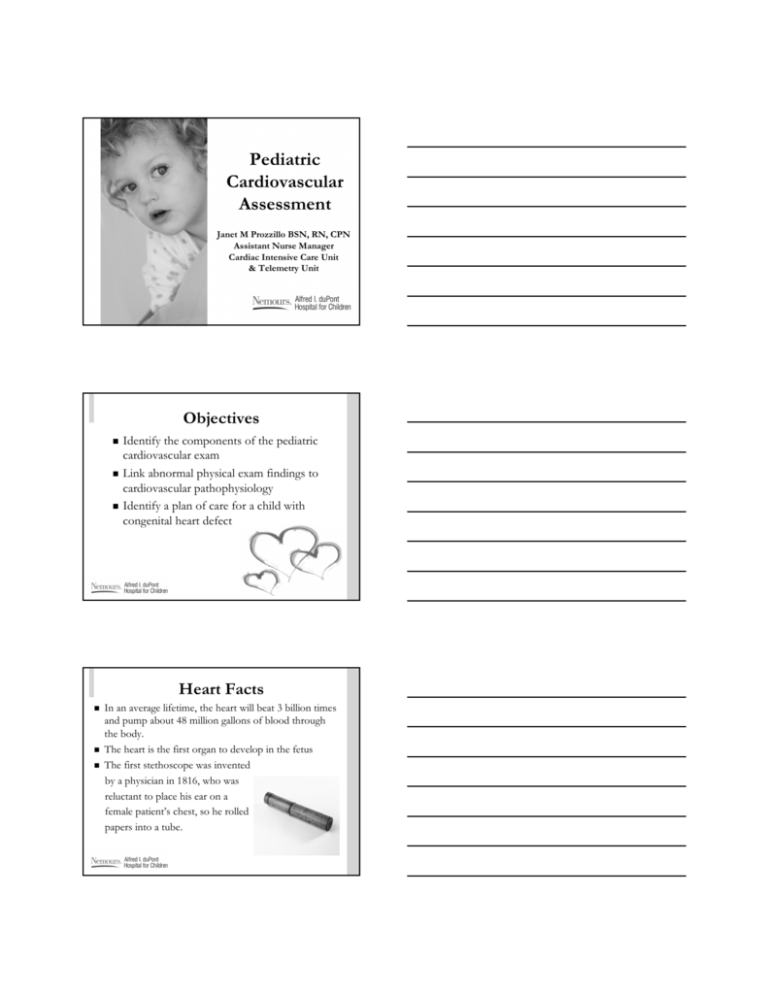
Pediatric Cardiovascular Assessment Janet M Prozzillo BSN, RN, CPN Assistant Nurse Manager Cardiac Intensive Care Unit & Telemetry Unit Objectives Identify the components of the pediatric cardiovascular exam Link abnormal physical exam findings to cardiovascular pathophysiology Identify a plan of care for a child with congenital heart defect Heart Facts In an average lifetime, the heart will beat 3 billion times and pump about 48 million gallons of blood through the body. The heart is the first organ to develop in the fetus The first stethoscope was invented by a physician in 1816, who was reluctant to place his ear on a female patient’ patient’s chest, so he rolled papers into a tube. Internal Normal Heart (Frontal View) The coronary arteries branch off the aorta and supply blood to the conduction system and the myocardium The History and Physical Taking a History Chief complaint Prenatal, perinatal and family history Feeding patterns Fatigue Edema Dyspnea/tachypnea Cyanosis Growth and Development Medications Psychosocial history Physical Examination General appearance Size for age, level of consciousness and activity level Physical characteristics suggesting chromosomal defects Note pallor, cyanosis, mottling or edema Temperature of extremities and diaphoresis Assess vital signs Use developmentally appropriate techniques; fear and anxiety will affect values Assessing Blood Pressure Normal blood pressure is lower in children than adults Upper extremities are the preferred site Document location and be consistent 4 extremity blood pressure should be obtained during initial assessment Assessing Blood Pressure Sitting position preferred with midpoint of arm at level of heart Palpate brachial artery and place index line of cuff inline with the pulse Rolling up a shirt sleeve may act as a tourniquet and give false BP or pulse assessments Cuff Size Determination The cuff should cover two third of the upper arm length and the bladder of the cuff should encircle 80–100 % of the circumference of the arm Assessing Heart Rate Listen with stethoscope to apical pulse for 1 minute Listen for fast rates, slow rates or an irregular rhythm Palpate pulse for 1 minute Brachial pulse for infants Radial pulse for children Heart Rate Heart rates of children are more variable than those of adults Fever, exercise, tension, crying, stress may elevate heart rate Normal Heart Sounds Extra Heart Sounds Murmurs Murmurs are heard because of turbulent flow through an abnormal opening or obstructed area Intensity based on a scale I Barely audible II Easily audible III Heard well in all positions IV Heard well with a palpable thrill V Louder, can be heard with stethoscope partly off the chest VI Heard with the stethoscope off the chest Auscultation URSB – Aortic valve ULSB – pulmonic valve LLSB – Tricuspid valve Apex – Aortic or mitral valve Pulses Best palpated over arteries close to surface of the body: carotid, brachial, radial, femoral, popliteal, dorsalis pedis, posterior tibial Use 2nd and 3rd fingers Palpate firmly but don’ don’t occlude artery Checking a pulse Peripheral Pulses Scale 4 = Bounding 3 = Full, increased 2 = expected 1 = diminished, barely palpable 0 = absent, not palpable Compare upper vs. lower extremity as well as right vs. left Capillary Refill Time Evaluated by compressing the extremity with moderate pressure and noting the time required for the blanched area to reperfuse Normal refill time is about 3 seconds Prolonged refill may be associated with poor systemic perfusion or a cool ambient temperature http://www.lond.ambulance.freeuk.com/paedcapreff.htm Assessing Respiratory Function Determine the ease or difficulty of respiration at rest and with activity Tachypnea Dyspnea Grunting Assess for absent or adventitious breath sounds such as crackles, wheezes or coarse sounds Presence of a cough Pulse Oximetry Pulse oximetry uses changes in infrared light to evaluate the level of saturated hemoglobin providing an indirect measurement of oxygen saturation Pulse oximetry can be used to evaluate and trend cyanosis in the pediatric cardiac population Clubbing develops after decreased oxygen saturation persists more than 6 months Palpating the Liver Start in the lower abdomen and press upward at the right costal margin until the liver edge is palpated Normal liver edge infant - 3 cm below 1 year old – 2 cm below 4 year old – 1 cm below Adolescent – not palpable Congenital Heart Disease Incidence of CHD is about 5 to 8 per 1000 live births About 2 or 3 per 1000 children will require treatment for the disease in the first year of life A major cause of death in the first year of life More than 35 well recognized cardiac defects VSD is the most common anomaly ASD Abnormal opening between the atria Blood flows from the high pressure LA to the lower pressure RA Increased flow of oxygenated blood to the right side Cardiac failure is unusual Mortality is less than 1% Clinical Manifestations of ASD May be asymptomatic Systolic murmur Risk for atrial dysrhythmias Usually repaired before school age Atrial Septal Defect – Patch Repair VSD Abnormal opening between the ventricles May vary in size Frequently associated with other defects 20 -60% will close on their own in the first year of life Single defects associated with low mortality <2% Clinical Manifestations of VSD CHF is common since higher pressures in the left ventricle shunt blood into the right ventricle overloading the pulmonary circulation Loud systolic murmur Children are at risk for bacterial endocarditis and pulmonary vascular disease VSD Surgical Treatment Patch closure is the procedure of choice Palliative treatment – pulmonary artery banding Complications include residual VSD and rhythm disturbances Pulmonary Artery Band Restricts pulmonary artery blood flow Coarctation of the Aorta Narrowing of the aorta near the insertion of the ductus Increased pressure proximal to the defect Decreased pressure distal to the defect Clinical Manifestation of Coarctation of the Aorta Higher pressures and bounding pulses in the arms Weak or absent femoral pulses Cool lower extremities Lower pressures in the lower extremities In critical coarct, the hemodynamics may deteriorate rapidly with severe acidosis and hypotension Treatment of COA Surgical repair is the treatment of choice Coarct portion is resected followed by an end to end anastomosis via thoracotomy incision Sometimes the constricted portion is enlarged with a graft Mortality is < 5% Tetralogy of Fallot VSD Pulmonic stenosis Overriding aorta RV hypertrophy Hemodynamics vary widely dependent upon the position of the aorta and the difference between PVR and SVR Clinical Manifestations of TOF May be acutely cyanotic at birth or have mild cyanosis progressing over the first year Moderate systolic murmur May have “tet spells” spells” or profound hypoxic which require prompt treatment Repair usually occurs within the first year of life Mortality is < 3% Treatment of TOF Closure of the VSD Resection of the pulmonary stenosis with a patch to augment the RVOT Requires a median sternotomy and the use of cardiopulmonary bypass Palliative Treatment of TOF Modified BlalockBlalockTaussig Shunt Provides blood flow to the pulmonary arteries from the right or left subclavian arteries Used in infants with other medical issues that make it unsafe for complete repair Congestive Heart Failure Right Sided Left Sided The inability of the heart The inability of the heart to pump an adequate amount of blood to the pulmonary artery Increasing pressure in the systemic venous circulation to pump an adequate amount of blood to the systemic system to meet the body’ body’s metabolic demand Increased pressure in the atrium and pulmonary veins Clinical Manifestations of CHF Pulmonary Congestion – tachypnea, dyspnea, retractions, flaring, exercise intolerance, cough, cyanosis, wheezing and grunting Venous Congestion - weight gain, hepatomegaly, edema, ascites and neck vein distention Impaired Myocardial Function – tachycardia, sweating, decreased urine, fatigue, decreased BP, weak pulses, cool mottled extremities and cardiomegaly Caring For The Child With CHF Assess and record VS Notify physician of abnormal assessment findings Daily weight Accurate record of I & O Small frequent feeds Organize nursing care to allow for rest Administer diuretics and cardiac drugs on schedule Educate patient and family Thanks to all of You! In the last 25 years, advances in the treatment of heart defects have enabled a half of a million U.S. children with significant heart defects survive into adulthood References Hockenberry, M., & Wilson, D.( 2009). Essentials of Pediatric Nursing. St Louis, MO: Mosby Elsevier. Slota, M (Ed.). (2006). Core Curriculum for Pediatric Critical Care Nursing. St Louis, MO: Saunders Elsevier. Selekman, J., & Jakubik, L. (2008). Pediatric Nursing Certification Review. Pensacola, FL: Society of Pediatric Nurses. Nurses. Daniels, P., Gura, P., Hitchcock, S., Stein, L., Thompson, J., & Bechtel, S. (2009). Body, The Complete Human. Washington, DC: National Geographic Society. Everett, A., (2009). PedHeart Resource [Power Point Slides]. retrieved from http://www.heartpassport.com. Janet M Prozzillo BSN, RN, CPN Nemours/AI duPont Hospital For Children 1600 Rockland Road Wilmington DE 302302-651651-6254 jprozzil@nemours.org

